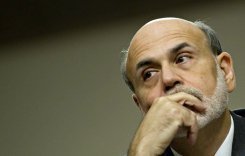 |
| Fed chairman Ben Bernanke © AFP/File Jim Watson |
WASHINGTON (AFP) – Federal Reserve policymakers gathered Tuesday amid deep divisions over policy and how to communicate their intentions, and as they updated their forecasts for the US economy.
As the Fed began a two-day meeting in Washington early Tuesday, observers speculated there was little chance the central bank will announce new actions to prod the economy.
The Fed has provided exceptional support to boost the US economy out of recession, including keeping interest rates between zero and 0.25 percent for nearly three years.
At the September meeting, its conventional arsenal limited, the policy-setting Federal Open Market Committee said it would shift $400 billion in shorter-term bond holdings to longer-term ones, with the aim of lowering long-term interest rates.
But this time, with growth in the world’s largest economy picking up from a near-stall in the first half of the year, the FOMC is expected to stand pat, turning its attention to new forecasts for economic growth, unemployment and inflation.
Even so, Fed chairman Ben Bernanke is likely to be pressed to justify any action, or non-action, at the post-meeting press conference.
He could however signal what the Fed is thinking about, policy-wise, in the coming months.
“The press conference, which follows what promises to be another contentious FOMC meeting, is the week’s main event,” IHS Global Insight economists Patrick Newport and Nigel Gault said in a research note.
Indeed, communication is now the focus of Fed-watchers: how the central bank indicates its medium and long-term policies, as a pointer, and perhaps incentive, to investors and bond buyers.
The Fed could decide to express an explicit inflation or nominal gross domestic product growth target, said Ryan Sweet at Moody’s Analytics.
“The other option is assigning specific economic conditions to its forward monetary policy guidance, a step for which there is growing support,” he said.
“Both changes would be significant and would have to be implemented with care not to muddle the Fed’s objectives or damage its credibility.”
 |
| Advertisement |
New economic assessments are expected to reflect sharp downward revisions to 2011-2013 forecasts and, for the first time, include numbers for 2014.
The International Monetary Fund in September estimated the US economy would grow at an annual 1.5 percent this year and 1.8 percent in 2012, far too weak a pace to bring down high unemployment bedeviling the US for more than two years.
For the economists at Nomura brokerage, the FOMC “will update its forecasts and likely reaffirm plans to extend the average maturity of securities holdings and to reinvest principal payments of agency debt/MBS (mortgage-backed securities).”
The FOMC announced on September 21 that it would reinvest some debt holdings into mortgage-backed securities to aid the depressed housing sector.
But the decision was not unanimous and, according to the minutes of the meeting, one dissenter said the action “would not benefit housing markets.”
Since then, several members have said they want the Fed to do more to stimulate growth, including another massive round of asset purchases, known as quantitative easing, if the economic outlook deteriorates.
They argue current inflation poses no real risk to the economy, and so stronger stimulative steps are justified to address unemployment.
But the government’s first estimate of third-quarter GDP growth Thursday, at 2.5 percent, was nearly double the prior quarter’s rate. That may cost their arguments traction.
Barclays Capital analysts said they expected the FOMC “to explore ways to improve transparency further and to discuss further policy easing options” if needed.
The Fed panel also may debate a proposal from Chicago Fed chief Charles Evans, a voting FOMC member, who said in a speech this month that the central bank should spell out the conditions affecting its dual-mandate responsibilities.
“We should consider committing to keep short-term rates at zero until either the unemployment rate goes below seven percent or the outlook for inflation over the medium term goes above three percent,” Evans said.
He acknowledged some may find that “risky.”
© AFP — Published at Activist Post with license
linkwithin_text=’Related Articles:’


Be the first to comment on "Divided Fed meets to discuss battle plan"